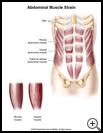
Abdominal Muscle Strain: Teen Version
What is an abdominal muscle strain?
A strain is a stretch or tear of a muscle or tendon. People commonly call such an injury a "pulled" muscle. Your abdominal muscles may be strained during a forceful activity.
How does it occur?
During a vigorous activity, such as lifting or even hard coughing or sneezing, these muscles may get strained. It may also occur from overuse, such as doing lots of sit-ups or crunches.
What are the symptoms?
You have pain in the abdominal muscles.
At times these muscles may be torn. A tear all the way through the muscles and the fascia may result in an abdominal wall hernia. Fascia is a strong layer of connective tissue between the skin and muscles. In a hernia, some of the contents of the belly (intestines and tissue) poke through the tear and cause a bulge in the abdominal wall.
How is it diagnosed?
Your healthcare provider will examine your abdomen. He or she will ask you to do an exercise such as a sit-up or abdominal "crunch" to check your symptoms. If you have a hernia, your provider will be able to feel and see a bulge in your abdomen. You may have an MRI.
How is it treated?
To treat this condition:
- Put an ice pack, gel pack, or package of frozen vegetables, wrapped in a cloth on the area every 3 to 4 hours, for up to 20 minutes at a time.
- Take an anti-inflammatory medicine such as ibuprofen, or other medicine as directed by your provider. Nonsteroidal anti-inflammatory medicines (NSAIDs) may cause stomach bleeding and other problems. These risks increase with age. Read the label and take as directed. Unless recommended by your healthcare provider, do not take for more than 10 days.
If you have an abdominal hernia you may need surgery.
When can I return to my normal activities?
Everyone recovers from an injury at a different rate. Return to your normal activities depends on how soon your muscle recovers, not by how many days or weeks it has been since your injury has occurred. In general, the longer you have symptoms before you start treatment, the longer it will take to get better. The goal is to return to your normal activities as soon as is safely possible. If you return too soon you may worsen your injury.
You may return to your normal activities when you can bend at the waist to touch your toes and straighten back up without pain. If you have a hernia, be cautious about doing strenuous abdominal activities and talk to your healthcare provider about having it repaired.
How can I prevent abdominal muscle strains?
The stronger and more flexible your muscles are, the less likely they will be strained. You can tone these muscles by doing sit-ups or abdominal crunches. It is important not to overdo it when starting an exercise program. When you lift heavy objects, lift correctly, with knees bent and your back straight.
Last modified: 2011-06-08
Last reviewed: 2009-12-28

